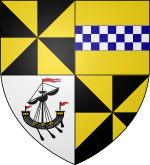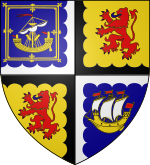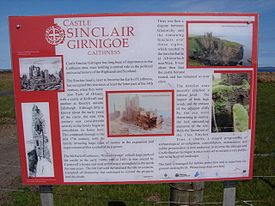Battle of Altimarlach facts for kids
The Battle of Altimarlach was a Scottish clan battle that happened on 13 July 1680, near Wick, Highland, Scotland. It was a fight between Sir John Campbell of Glenorchy and George Sinclair of Keiss. They were arguing over who had the right to be the Earl of Caithness and own the lands that came with the title. The battle involved men from Clan Campbell and Clan Sinclair. Campbell of Glenorchy won the battle, but Sinclair of Keiss later used the law to get the title of Earl of Caithness.
Quick facts for kids Battle of Altimarlach |
|||||||
|---|---|---|---|---|---|---|---|
| Part of the Scottish clan wars | |||||||
  Coats of Arms of Campbell, Earl of Breadalbane (left) and Sinclair, Earl of Caithness (right) |
|||||||
|
|||||||
| Belligerents | |||||||
| Clan Campbell | Clan Sinclair | ||||||
| Commanders and leaders | |||||||
| Sir John Campbell of Glenorchy | George Sinclair of Keiss | ||||||
| Strength | |||||||
| Accounts vary from 700 to 1100 men | Accounts vary from 400 to 1500 men | ||||||
| Casualties and losses | |||||||
| very low | Accounts vary from 80 to 200 men killed | ||||||
Contents
Why the Battle Happened
The Battle of Altimarlach was fought because of a big disagreement over land and a noble title.
Dispute Over Land and Title
Before he died in 1675 or 1676, George Sinclair, 6th Earl of Caithness, owed a lot of money. He sold his lands to John Campbell, Lord Glenorchy, who was one of the people he owed money to. Glenorchy then married the Earl's widow and took the title of Earl of Caithness.
However, George Sinclair of Keiss, who was related to the previous Earl, said that he should have inherited some of these lands. He also believed he was the rightful Earl of Caithness. In 1678, Sinclair of Keiss took control of some of the disputed lands.
Legal Fight and Royal Orders
Both Campbell and Sinclair took their claims to four important lawyers in Scotland. The lawyers decided that Glenorchy was right. They sent their decision to King James VII of Scotland. The King then ordered the Privy Council of Scotland to announce that George Sinclair of Keiss was not allowed to use the title of Earl of Caithness.
But Sinclair of Keiss ignored this order. He kept the lands he claimed and made it very hard for Glenorchy's staff to collect rents. Many local gentlemen and common people supported Sinclair of Keiss. They saw Glenorchy as someone who had unfairly taken advantage of the late Earl to get his land and title. They even helped Sinclair of Keiss tear down Thurso East Castle, which Glenorchy had taken over.
In November 1679, the Privy Council passed a law. It told all of Campbell's family, friends, and followers to help him get back the disputed lands.
The Battle of Altimarlach
The battle took place in the summer of 1680, when Campbell of Glenorchy marched into Caithness.
Armies Gather for Conflict
In 1680, Glenorchy led an army of about 700 to 1100 men into Caithness. This force included his own family members and allies like the Laird of Macnab. Sinclair of Keiss gathered his own men to meet them. Some reports say he had 400 men, while others claim up to 1500.
Many of Sinclair's men were not trained soldiers. The only experienced fighter on his side was Major Sinclair of Thura, who had fought in wars abroad.
A Tricky Start to the Fight
The two sides first met near Stirkoke. Glenorchy's men were tired from marching nearly 30 miles, so he decided not to fight that day and moved his troops to the hills. The Sinclairs went to Wick and celebrated their supposed advantage. It is said they drank a lot of alcohol, which was secretly supplied by someone working for the Campbells.
The next morning, on 13 July 1680, Glenorchy crossed the River Wick. The Sinclairs, still feeling the effects of the previous night's drinking, quickly gathered. Major Sinclair of Thura suggested waiting until the next day so his men could recover, but his advice was ignored.
The Ambush and Rout
Glenorchy had planned to march to Keiss. But when he saw the Sinclairs coming, he prepared for battle. He placed 500 of his men near the burn of Altimarlach. He ordered the rest of his men to hide in a deep gorge and wait for orders. The Sinclairs did not see this hidden force.
Major Sinclair of Thura advised his men to let the Campbells cross the ravine first, then attack them as they struggled up the banks. But the Sinclairs ignored him and rushed across the burn in a messy way. This put them in a bad position.
When the two armies were very close, Glenorchy ordered his men to attack. The Campbells charged fiercely. The Sinclairs, weakened by drink, quickly broke ranks and ran towards the Altimarlach burn. At that moment, the hidden Campbell force rose from the gorge and ambushed them. The Sinclairs desperately tried to reach the river, but the Campbells chased them into the water. Many drowned, and others who tried to escape across the open land were cut down with battle axes and broadswords.
Legend says so many Sinclairs were killed that the Campbells could cross the river without getting their feet wet. Reports vary, but between 80 and 200 Sinclairs were killed in the battle.
What Happened After the Battle
After their victory, Glenorchy and some of his troops stayed in Caithness for a while. They collected rents and taxes from the people. However, George Sinclair of Keiss did not give up. He attacked Castle Sinclair Girnigoe and captured it.
But the political situation changed, and Sinclair of Keiss gained support. He then tried to win his inheritance through the law. With help from the Duke of York (who later became King James VII of Scotland), George Sinclair of Keiss officially became the Earl of Caithness on 15 July 1681. His lands were returned to him on 23 September. As a result, Campbell of Glenorchy was given the title of Earl of Breadalbane as a form of payment.
The Last Clan Battle

The Battle of Altimarlach is often called the last true clan battle fought between Scottish clans. Another battle, the Battle of Mulroy in 1688, is sometimes given this title. However, in the Battle of Mulroy, one side had official government support and included government troops. This means the Battle of Altimarlach, fought in 1680 between the Campbells and Sinclairs, is generally seen as the last private battle between Scottish clans.
Music and Poems About the Battle
The Battle of Altimarlach inspired music and a poem.
Pipe Music
Members of the Clan MacIver from Argyll and Caithness joined Glenorchy's forces. It is said that Finlay MacIver, a piper from Caithness, created the Great Highland bagpipe tune Bodach-na-briogais after the battle. Another well-known piping tune, The Campbells Are Coming, is also believed to have been composed by Glenorchy's piper, Findlay MacIver, around this time. The tune The Braes of Glenorchy also got its name during this period.
A Ballad
A long poem, called a ballad, was written to remember the battle. It was published in 1861 by historian James Tait Calder. The ballad describes the events of the battle, from the Sinclairs celebrating in Wick to their defeat and the sad aftermath for their families. It also mentions how Glenorchy's rule in Caithness was disliked and how Sinclair of Keiss eventually won back his rightful title.

